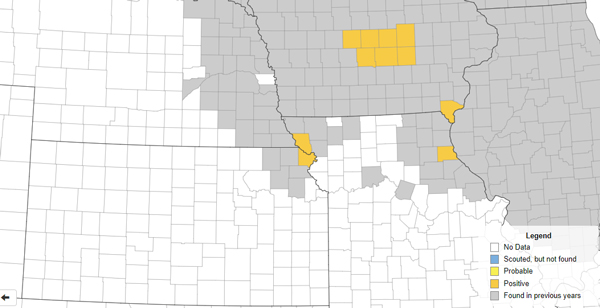Tar spot of corn, a disease caused by the fungus Phyllachora maydis, was confirmed in several fields in Doniphan County, Kansas on June 26, 2023 (Figure 1). Now is the time to intensify scouting efforts. If you wait until there is significant disease in the upper canopy then a fungicide application may be too late.

Figure 1. Example of tar spot of corn (A) and a close-up on the tar spot lesions (B). Photo courtesy of Rodrigo Onofre, K-State Research and Extension
The early disease onset that we’re observing this year raises concern for yield loss. Although it is important to keep in mind that we are still learning about this disease in Kansas. However, we can look to neighboring states who have battled tar spot for multiple years now. Generally, early observations of tar spot have corresponded with high yield loss. Fields scouted this week were between V-8 to V14 growth stage, which adds a higher risk for disease spread and development. In some of the fields, we were able to find low levels of tar spot on the second leaf below the ear leaf (Figure 2A and 2B) and at higher levels in the lower leaves (Figure 2C and 2D). There is a good chance that the disease will spread to the ear leaf and neighboring fields, as multiple cycles of the disease can occur during the growing season. The recent rains likely helped to promote tar spot development. Additionally, irrigated corn may be at particularly high risk for yield or silage loss.

Figure 2. Tar spot lesions on the mid-canopy (A and B) and lower leaves (C and D). Photos courtesy of Rodrigo Onofre, K-State Research and Extension
Frequently Asked Questions about Tar Spot
What am I scouting for?
Tar spot develops as small, black, raised spots (circular or oval) that develop on infected plants, and may appear on one or both sides of the leaves, leaf sheaths, and husks. Spots may be found on both healthy (green) and dying (brown) tissue. Tar spot can be easily confused with insect poop, which can appear as black spots on the surface of the leaf. If you would like assistance in confirming tar spot you can contact your local county extension office or the K-State plant diagnostic clinic (https://www.plantpath.k-state.edu/extension/plant-disease-diagnostic-lab/).
Is there a history of disease in this field or neighboring fields?
Tar spot overwinters on infested corn residue on the soil surface, which serves as a source of inoculum for the subsequent growing season. Spores can be dispersed by wind and rain splash and can move to nearby fields if conditions are favorable.
What growth stage is the field?
Research has shown that making an application just after first detection and at or after VT is effective if lesions are detected early. If you wait until there is significant disease in the upper canopy then a fungicide application may be too late. Here you can find a guide for growth stages in corn: https://bookstore.ksre.ksu.edu/pubs/MF3305.pdf
How does moisture influence disease development?
The recent rains likely helped to promote tar spot development. Additionally, irrigated corn may be at particularly high risk for yield or silage loss. Forecasted rainfall and high humidity will favor tar spot development and spread.
Should I apply a fungicide?
Fungicides are an effective tool for controlling tar spot if they are timed well. Research has shown the best return on investment from a fungicide application on corn occurs when fungal diseases are active in the corn canopy. A well-timed, informed fungicide application will be important to reduce disease severity when it is needed, and we recommend holding off until the disease is active in your field and corn is at least nearing VT/R1 (tassel/silk) or even R2 (blister). Scouting will be especially important if wet weather continues. There are several fungicides that are highly effective at controlling tar spot when applied from tassel (VT) to R2 (blister). I would recommend picking a product with multiple modes of action. The National Corn Disease Working Group has put together efficacy ratings for fungicides labeled for the control of tar spot can be found at the Crop Protection Network website at https://cropprotectionnetwork.org/publications/fungicide-efficacy-for-control-of-corn-diseases.
If there is high disease pressure early in the season, a second application may be warranted. Fields should be scouted 14-21 days after the first application to see if tar spot has become active again. Fungicides will not provide benefits after R5. Always consult fungicide labels for any use restrictions prior to application.
Where has tar spot been reported in the 2023 season?
Tar spot has been detected in 8 counties in Illinois, 2 counties in Missouri, and 1 county (Doniphan) in Kansas (Figure 3).

Figure 3. Tar Spot of Corn (Phyllachora maydis) in Kansas and surrounding states in 2023. Source: https://corn.ipmpipe.org/tarspot/
Please help us track tar spot! You can contact Rodrigo Onofre directly at 785-477-0171 if you suspect a field has tar spot and/or submit a sample to the K-State Plant Disease Diagnostic Lab at https://www.plantpath.k-state.edu/extension/diagnostic-lab/documents/2021_PP_DiseaseLabChecksheet.pdf.pdf. This will help us monitor the situation in the state.
Rodrigo Onofre, Row Crop Plant Pathologist
onofre@ksu.edu
Tags: corn fungicide foliar fungicides foliar diseases tar spot